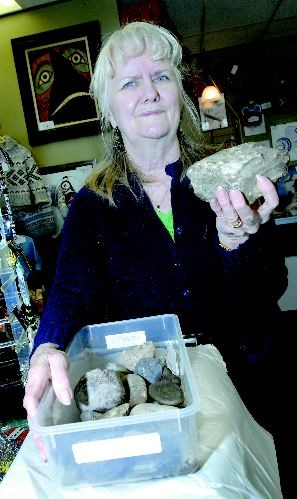Downtown business owner Carolyn Kendall wants to know where the large stones littering the roads near her business are coming from.
Last spring a window at her business was damaged by rocks, costing her $1,200 to repair, she said. Though thankfully, no one was injured.
Within a month, Kendall has collected a bucket of large rocks outside her shop, the Kumbayaz Native Arts on Dominion Street and Fourth Avenue.
"That's only capturing the ones that are resting along the curb area," she said.
In addition to the dangers such rocks create when passing vehicles throw them, she said, they provide a handy tool for vandals.
Kendall has a theory it's the city's sand trucks that are leaving the potential projectiles behind.
"This is always after they put the dirt after the roads," she said. "City Hall says they screen the stuff they put in the truck. Obviously they are not screening it very good."
Kendall said she "very rarely" sees large rocks on the road once the sanding season is over, and she rarely sees logging trucks or other heavy vehicles which could be dropping the rocks on the road along Fourth Avenue and Dominion Street.
"Yesterday I saw three transport [trucks] and said, 'Holy smokers, that's rare.'"
Andy Townsley, owner of A Plus Automatic Door and Storefront, said he sees downtown business windows damaged by rocks three to four times a year.
"I know there is quite a few more than that, I'm just a small glass shop," Townsley said. "It's definitely an issue. [But] it's just part of doing business in Prince George."
Northway Glass owner Todd White said rocks on the road are just part of life in the North.
"The best rock for breaking a window is a smaller one, they travel faster and farther. Usually what we run into is people spinning their tires on the ice in parking lots."
A brief inspection of curbs in a one-block radius of the Prince George Citizen office on Brunswick Street found four approximately egg-sized rocks -- an average of one per block.
City takes measures to ensure safety
City street operations supervisor Mick Jones said the city takes every reasonable measure to ensure the gravel it distributes on city roads is half an inch in diameter or less.
"The material that we use, the contractor is required to get it tested for gradation. We also take quality control samples," Jones said. "We have a Grizzly, that is basically a large screen, that breaks up the frozen chunks and screens out the larger rocks. [And] the truck has a gate that allows a certain gradient of rock through."
Despite those measures, it is possible some larger rocks do get through, he said.
"I can't say that it's not possible that a large rock could get through our sanding material. We don't test every load," Jones said. "We do everything we can to ensure it's not happening."
According to the city's website, between 1996 and 2008 city crews distributed an average of 2,729 tonnes of gravel and 13,842 tonnes of sand per year.
However not all the sand and gravel which ends up on city streets comes from city, Jones said.
Provincial highways contractor YRB sands Highways 16 and 97 within city limits, he said, and private contractors sand parking lots throughout the city. In addition, logging trucks and other off-road vehicles can track rocks onto city streets, he said.
"The majority of the material on the road is from the city. [But] not every rock that is out there is from a city truck," he said. "I think there is probably some [sand and gravel] products from other contractors which have larger material and are cheaper."
Jones said when the city receives a complaint about rocks from the streets damaging windows they will look into it and, if found by the city to be legitimate, will pay compensation.
"We do try to do the right thing by people."



